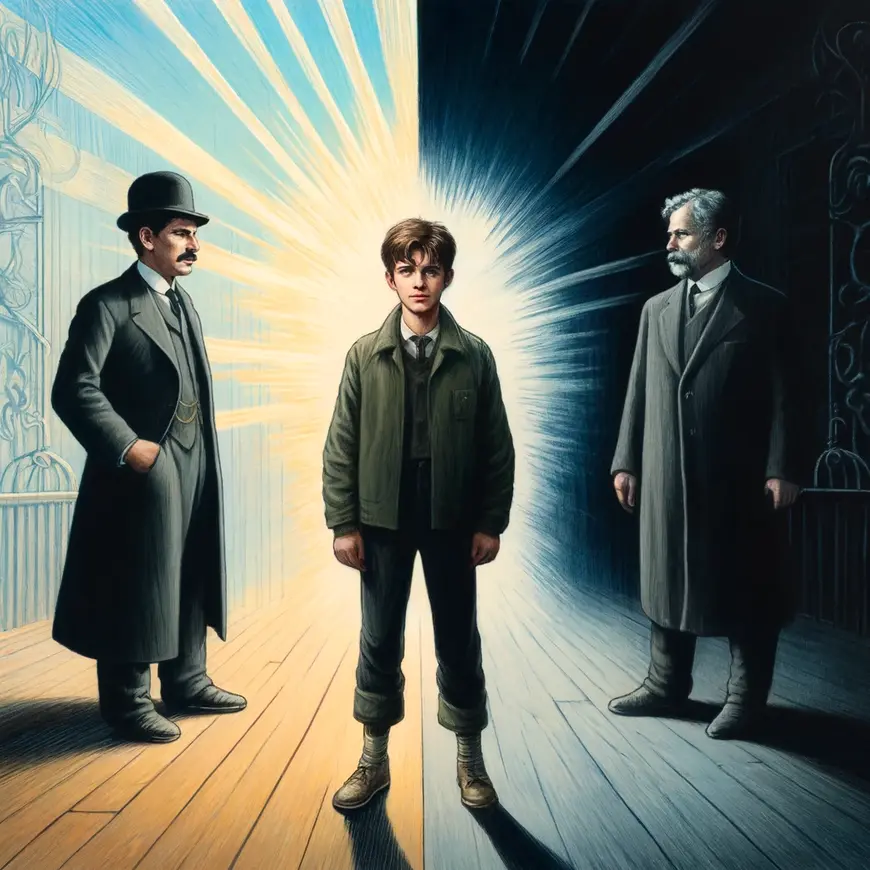The Labyrinth of Self-Discovery – A Review of “Demian” by Hermann Hesse
Unveiling the Inner Odyssey – A Deep Dive into Hermann Hesse’s “Demian”
In the tapestry of literature that explores the intricacies of the human spirit, Hermann Hesse‘s “Demian” stands as a powerful exploration of identity, self-discovery, and the duality of human nature. With prose that dances between introspection and philosophical contemplation, Hesse crafts a narrative that invites readers to embark on an inner odyssey, tracing the journey of a young man as he navigates the complexities of existence.
A Voyage Within: The World of “Demian”
Imagine a world where reality and illusion blend seamlessly, where the boundaries between self and other become fluid. “Demian” introduces us to Emil Sinclair, the novel’s protagonist, as he traverses the tumultuous landscape of youth and awakening. Through his encounters with enigmatic figures like Demian and Pistorius, Sinclair is drawn into a world that challenges his perceptions and forces him to confront the dualities that shape his reality.
The setting of “Demian” is not confined to physical space; it’s a canvas upon which the inner struggles of the characters play out. Hesse’s exploration of the psyche is as vivid as any external landscape, inviting readers to peer into the depths of human consciousness.

The Power of Influence: Characters in the Spotlight
The heart of “Demian” beats within its characters, each a vessel through which Hesse explores the complexities of human nature. Emil Sinclair serves as the reader’s guide, his journey mirroring the universal quest for meaning and self-discovery. Demian, the enigmatic figure who becomes Sinclair’s mentor, challenges conventional beliefs and opens the door to a world of metaphysical exploration.
Pistorius, a professor, is another crucial character whose intellectual guidance shapes Sinclair’s worldview. Hesse’s portrayal of these characters is layered, blurring the lines between mentorship and mysticism, and allowing readers to contemplate the interplay between influence and personal growth.
Themes of Duality and Self-Discovery: Insights Explored
“Demian” delves into themes that resonate deeply with the human experience. The exploration of duality – the interplay between light and darkness, good and evil, self and other – is a central motif. Hesse’s narrative encourages readers to confront the multifaceted nature of existence and to question the simplistic binaries that often define our understanding of the world.
Self-discovery is another prominent theme that unfolds throughout the narrative. Sinclair’s journey is one of both internal and external exploration, as he grapples with his own identity and seeks to align his inner truth with the expectations of society. Hesse’s portrayal of self-discovery is both personal and universal, inviting readers to reflect on their own paths of growth and self-awareness.
Prose That Echoes Thought: Hesse’s Writing Style in “Demian”
Hermann Hesse’s writing style is a delicate dance between introspection and philosophical exploration. His prose is as much about the thoughts and emotions of the characters as it is about the ideas they represent. The novel’s narrative structure is a blend of Sinclair’s personal reflections and his interactions with the world around him.
Hesse’s language is contemplative, often bordering on the metaphysical. His descriptions evoke sensory experiences while also delving into the deeper layers of meaning. The novel’s introspective quality allows readers to inhabit the minds of the characters, immersing themselves in the inner struggles and philosophical inquiries that shape the narrative.
The Quest for Authenticity: Relevance Today
While “Demian” is rooted in its historical context, its themes of identity, self-discovery, and the search for authenticity remain relevant in the modern world. In an era marked by constant connectivity and the pressure to conform to societal norms, Hesse’s exploration of individuality and the quest for personal truth serves as a poignant reminder of the importance of self-awareness.
The duality of human nature and the complexity of the human psyche continue to be subjects of exploration and debate in psychology, philosophy, and literature. Hesse’s portrayal of these themes encourages readers to engage with the nuances of their own emotions, motivations, and choices.

Famous Quotes from “Demian” by Hermann Hesse
- “The bird fights its way out of the egg. The egg is the world. Who would be born must destroy a world.”
- Explanation: This quote encapsulates the theme of personal transformation and the struggle for self-realization. The bird breaking out of the egg symbolizes the individual breaking free from societal norms and constraints to discover their true self. The process is often painful and involves destroying old beliefs and structures to be reborn into a new understanding of oneself.
- “I wanted only to try to live in accord with the promptings which came from my true self. Why was that so very difficult?”
- Explanation: This quote highlights the central conflict in the protagonist Emil Sinclair’s journey: the difficulty of living authentically. Sinclair grapples with societal expectations and his inner desires, finding it challenging to align his actions with his true self. This struggle is a common theme in Hesse’s works, emphasizing the importance of self-discovery and authenticity.
- “We are sun and moon, dear friend; we are sea and land. It is not our purpose to become each other; it is to recognize each other, to learn to see the other and honor him for what he is: each the other’s opposite and complement.”
- Explanation: This quote speaks to the relationship between Sinclair and Demian, as well as the broader theme of duality. Hesse suggests that true understanding and harmony come from recognizing and accepting the differences in others. This recognition allows individuals to see themselves more clearly and understand the complementary nature of opposites.
- “The way to innocence, to the uncreated and to God leads on, not back, not back to the father, to childhood. Forward, not back, must be our direction.”
- Explanation: This quote emphasizes the importance of moving forward in one’s spiritual and personal journey. Rather than seeking a return to innocence or an idealized past, Hesse advocates for progression and growth. This forward movement is essential for reaching a higher state of consciousness and spiritual fulfillment.
- “I have been and still am a seeker, but I have ceased to question stars and books; I have begun to listen to the teaching my blood whispers to me.”
- Explanation: This quote reflects Sinclair’s shift from external sources of knowledge and guidance to an internal, intuitive understanding. Hesse underscores the importance of self-reliance and inner wisdom in the journey of self-discovery. By listening to his own instincts and desires, Sinclair finds a more authentic path to enlightenment.
Trivia Facts about “Demian”
- Pseudonymous Publication: “Demian” was originally published in 1919 under the pseudonym Emil Sinclair, the name of the novel’s protagonist. Hermann Hesse chose this pseudonym to distance himself from the work initially, allowing the book to stand on its own merits without the influence of his established reputation.
- Influence of Carl Jung: The novel was significantly influenced by the ideas of Carl Jung, particularly his concepts of individuation and the collective unconscious. Hesse was deeply interested in Jungian psychology, and this interest is reflected in the novel’s exploration of the protagonist’s inner life and his journey towards self-discovery.
- World War I Context: “Demian” was written during and after World War I, a time of great personal and societal upheaval. The novel reflects Hesse’s own struggles with identity and the broader existential crises facing Europe at the time. The themes of inner conflict, spiritual awakening, and the search for meaning resonated with many readers in the post-war period.
- Symbolism of Abraxas: One of the central symbols in “Demian” is Abraxas, a deity that embodies both good and evil. This dualistic figure represents the novel’s theme of embracing all aspects of the self, including the dark and light sides. Abraxas serves as a metaphor for the integration of opposites and the acceptance of the full spectrum of human experience.
- Inspiration for the Counterculture Movement: “Demian” gained renewed popularity during the 1960s and 1970s, particularly among the counterculture and hippie movements. Its themes of self-discovery, rebellion against societal norms, and spiritual exploration resonated with young people seeking alternative lifestyles and philosophies. The novel became a symbol of the quest for personal and collective enlightenment.
Final Thoughts on “Demian” : A Journey of Inner Alchemy
Hermann Hesse’s “Demian” is a literary gem that invites readers on a journey of inner alchemy. Through the eyes of Emil Sinclair, Hesse navigates the labyrinth of human consciousness, exploring the depths of identity, the dance of duality, and the transformative power of self-discovery.
The novel encourages readers to embrace the complexities of their own existence, to confront the shadows that reside within, and to engage with the philosophical inquiries that shape their understanding of the world. “Demian” is an invitation to embark on a voyage of introspection, to peel back the layers of reality, and to uncover the eternal truths that lie beneath the surface of life’s illusions.
In the end, “Demian” is more than a novel; it’s a mirror that reflects the universal quest for meaning and authenticity. Through Hesse’s intricate prose and profound insights, readers are reminded that the journey of self-discovery is a transformative process, one that illuminates the depths of our own souls and unveils the intricate tapestry of human existence.
Reviews of other Works by Hermann Hesse
“The Glass Bead Game” by Hermann Hesse: A Symphony of Intellect and Spirituality Hermann Hesse’s “The Glass Bead Game” beckons…
A Spiritual Odyssey – The Path of Self-Discovery in Hermann Hesse’s “Siddhartha” Embarking on the Journey Within – Exploring the…
The Academic Abyss: “Beneath the Wheel” by Hermann Hesse “Beneath the Wheel” by German writer Hermann Hesse is a poignant…
A Haunting Journey of Self-Discovery: The Profound Depths of “Narcissus and Goldmund” by Hermann Hesse In the realm of literary…
A Journey into the Psyche: A Review of Hermann Hesse’s “Steppenwolf” Hermann Hesse’s “Steppenwolf” is a thought-provoking and deeply introspective…




